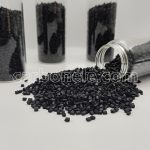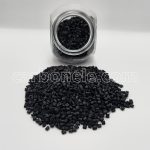
High Quality PA610 CF40 at Competitive Prices
PA610 CF40 compounds are blends of polyamide 610 (PA610) reinforced with 40% carbon fiber. They provide enhanced mechanical properties such as strength, stiffness, and dimensional stability for industrial use.
- Model: PA610-CF-BCA4
- Manufacturer: Yes
- OEM services: Acceptable
- Free samples: 1-10kgs
- Molding process: Injection/extrusion
- Color: Black
What are PA610 CF40 compounds?
PA610 CF40 compounds refer to Polyamide 610 (PA610) blended with 40% Carbon Fiber (CF), creating a high-performance composite material renowned for its exceptional mechanical strength, stiffness, and other advantageous properties. PA610 itself is a semi-crystalline polyamide known for its toughness, excellent wear resistance, high melting point, and resistance to chemicals, making it suitable for a wide range of industrial applications.
**Key Properties:**
1. **Mechanical Strength:** The addition of 40% carbon fiber significantly enhances the tensile strength and modulus of PA610 CF40 compared to unfilled PA610. Carbon fibers are renowned for their high strength-to-weight ratio, providing robust reinforcement that allows the composite to withstand heavy mechanical loads and stresses. This makes PA610 CF40 compounds suitable for structural components requiring superior strength and durability.
2. **Stiffness:** Carbon fibers impart high stiffness to the PA610 matrix, enhancing the material’s dimensional stability and resistance to deformation under load. This property is crucial in applications where rigidity and precise dimensional control are essential, such as automotive and aerospace structural parts.
3. **Impact Resistance:** Despite their stiffness, PA610 CF40 compounds exhibit good impact resistance, which is a notable advantage in applications where components may experience sudden loads or impacts. This property ensures that parts maintain their integrity and performance under demanding operating conditions.
4. **Heat Resistance:** PA610 inherently offers good heat resistance, and the addition of carbon fiber further enhances this property. PA610 CF40 compounds can withstand elevated temperatures, making them suitable for applications exposed to heat and thermal cycling, such as engine components in automotive and industrial equipment.
5. **Dimensional Stability:** The combination of PA610 and 40% carbon fiber reinforcement improves the composite’s dimensional stability. This ensures that parts maintain their shape and size over time, even under varying environmental conditions and mechanical stresses, reducing the risk of warping or distortion.
6. **Chemical Resistance:** PA610 CF40 compounds retain the chemical resistance characteristic of PA610, making them resistant to oils, greases, and many solvents. This property is beneficial in applications exposed to harsh chemical environments, such as automotive and industrial components.
7. **Lightweight:** Despite the high loading of carbon fiber, PA610 CF40 compounds remain relatively lightweight compared to metals. This contributes to overall weight reduction in components, which is advantageous in industries striving to improve fuel efficiency and reduce environmental impact.
8. **Electrical Insulation:** PA610 CF40 compounds exhibit good electrical insulation properties, making them suitable for applications where high mechanical strength, thermal stability, and electrical insulation are required simultaneously, such as electrical connectors and housings.
**Applications:**
– **Automotive:** PA610 CF40 compounds find extensive use in automotive applications such as structural reinforcements, engine components (e.g., intake manifolds, covers), transmission components, and under-the-hood parts. The materials’ combination of high strength, stiffness, and heat resistance makes them ideal for parts subjected to demanding mechanical and thermal conditions.
– **Aerospace:** In aerospace, PA610 CF40 compounds are utilized in structural components, brackets, panels, and other critical parts where lightweight materials with exceptional mechanical performance are essential. They contribute to reducing the overall weight of aircraft while ensuring structural integrity and reliability.
– **Industrial Equipment:** PA610 CF40 compounds are employed in industrial machinery for manufacturing components such as gears, bearings, rollers, and housings. Their durability, chemical resistance, and dimensional stability make them suitable for heavy-duty applications in manufacturing and processing industries.
– **Consumer Goods:** These compounds are also used in consumer goods such as sporting equipment, outdoor gear, tool handles, and high-performance parts where lightweight, durable materials are desired.
PA610 CF40 compounds offer a robust solution for industries requiring high-performance materials with superior mechanical properties. The combination of PA610’s inherent characteristics with 40% carbon fiber reinforcement provides a versatile material option suitable for diverse applications across automotive, aerospace, industrial equipment, and consumer goods sectors.
Content Block 1
Morbi iaculis at quam vel faucibus. Ut semper ipsum ex, quis aliquet justo pretium a. Suspendisse scelerisque metus augue, a interdum leo iaculis sed. Vivamus sit amet nunc odio. Duis vel pulvinar dolor, at lacinia tellus.
Pellentesque habitant morbi tristique senectus et netus et malesuada fames ac turpis egestas. Suspendisse lacinia quam a elit lobortis tempor


Content Block 1
Morbi iaculis at quam vel faucibus. Ut semper ipsum ex, quis aliquet justo pretium a. Suspendisse scelerisque metus augue, a interdum leo iaculis sed. Vivamus sit amet nunc odio. Duis vel pulvinar dolor, at lacinia tellus.
Pellentesque habitant morbi tristique senectus et netus et malesuada fames ac turpis egestas. Suspendisse lacinia quam a elit lobortis tempor

Frequently Asked Questions
Carbon (Xiamen) New Material Co., Ltd. aims to provide buyers with "one-stop" worry-free high-quality services. Here you can find all information about carbon fiber engineering plastics. If you still have questions, please send us an email for consultation!
-
How can I contact the manufacturer of a product that interests me?
When you find a product you are interested in, you can contact the manufacturer directly by sending an email and we will get back to you as soon as possible.
-
How do I find the products that interest me?
All you need to do is enter the keyword, product name in the search window and press the Enter key on your keyboard. Your search results page will then be displayed. You can also search within the product category pages on the home page. Each category is divided into subcategories, allowing you to refine your search and find products that interest you.
-
Where will I find a buying guide?
Please contact our after-sales service directly and we will provide you with a comprehensive operating guide.
-
What are CF Reinforced Thermoplastic Composites?
CF Reinforced Thermoplastic Composites are materials where carbon fibers are incorporated into a thermoplastic matrix. They combine the strength and stiffness of carbon fibers with the processability and recyclability of thermoplastics. For instance, they are used in automotive parts like bumper beams.
-
What are the benefits of CF Reinforced Thermoplastic Composites over traditional composites?
The key benefits include faster production cycles, easier recyclability, and better impact resistance. They also offer design flexibility. An example is in the manufacturing of consumer electronics casings where complex shapes can be achieved more easily.
-
How are CF Reinforced Thermoplastic Composites processed?
Common processing methods include injection molding, extrusion, and compression molding. Injection molding is widely used for mass production. For example, in the production of small components for the medical industry.
-
What industries use CF Reinforced Thermoplastic Composites?
They are utilized in aerospace, automotive, medical, and sports equipment industries. In aerospace, they can be found in interior components. In the medical field, they might be used in prosthetics.
-
How does the carbon fiber content affect the properties of the composites?
Higher carbon fiber content generally leads to increased strength and stiffness but may reduce ductility. A moderate content is often balanced for specific applications. For example, a higher content might be preferred in structural parts of a race car.
-
What are the challenges in using CF Reinforced Thermoplastic Composites?
Challenges include higher material costs, complex processing equipment requirements, and ensuring uniform fiber dispersion. Issues with adhesion between the fibers and the matrix can also arise. An example is in achieving consistent quality in large-scale production.

























